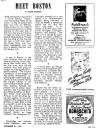
|
MEET BOSTON Friday, November 21, 1941 in What's New In Town W. J. Sidis |
The metropolitan equivalent of the famous “Toonerville Trolley that meets all the trains” is the so-called East Side bus line of Melrose. These buses run at irregular intervals between two railroad stations on the west side of the town, but are so timed as to meet all local trains stopping at those stations. Though the two ends of the line are not over a half mile apart, the buses cover over four miles zigzagging over the hills in eastern Melrose, near the Saugus line.
*
It was in Boston, in the early Nineties, that the idea arose of printing a boys’ magazine that broke away, for the first time, from the old tradition that that group of readers must be treated as infantile morons. The Youth’s Companion, as this magazine was called, immediately acquired great nation-wide popularity. It was located next to the freight sidings in the old Providence Depot yards―then passing through the present site of police headquarters; and the magazine’s old yellow building, at Berkeley Street and Columbus Avenue, is still standing, being now used by an insurance company. The magazine’s old emblem, an open book circled by a wreath, is still to be seen over the archways of the building’s doors―and, if you look closely, you can still distinguish faintly, on those emblems, the monogram YC.
*
Cambridge was formerly called Newtown, and was originally planned as a new capital for Massachusetts (Boston being intended, in 1630, as merely a temporary capital site till “the new town” was ready). It included, in Puritan days, Somervile, Arlington, Lexington, Brighton and Newton. The latter city is named for Cambridge’s old name, altered to conform to the name of the then lord of the treasury of England (the famous Sir Isaac Newton, known for the law of gravitation). Cambridge is more than just an educational center. It is also an important manufacturing city, and its candies, inks, stationery, road materials, and other manufactures are circulated all over America.
*
It would seem as though St. Mary were the patron saint of boundaries in Greater Boston. There is a St. Mary’s St. along the boundary between Boston and Brookline; and there is a St. Mary St. on the boundary between Malden and Medford.
*
Boston has the tallest waterfront structure in any Atlantic seaport. It is a fourteen-story building, built on top of a pier, called Litchfield’s Wharf, sticking out into Fort Point Channel. The location is approximately where a famous load of China tea was dumped into Boston Harbor in 1773, and it almost seems as though the building is some queer growth sprouted from the team of the Tea Party. The building is known as the Harbor Building, and is located at 470 Atlantic Avenue. It is mainly occupied by printing establishments.